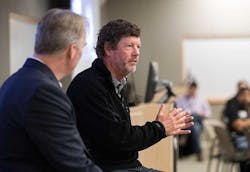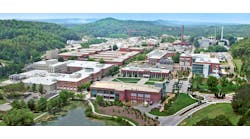SUNNYVALE, Calif. – In the world of data centers, the Sun casts a long shadow. The legacy of Sun Microsystems is seen today in the data center teams of the world’s largest technology companies.
Dozens of those alumni of Sun Microsystems took part in the Infrastructure Masons Leadership Summit, held April 19 at Microsoft’s Sunnyvale campus, which brought together more than 100 thought leaders from the data center and cloud industries. The event featured a Q-and-A with Sun co-founder and CEO Scott McNealy, plus several think tank sessions on the future direction of the Internet, which brought reminders of how the echoes of Sun’s corporate mantra – “The Network is the Computer” – can be seen in the emergence of distributed computing.
The Infrastructure Masons is a group founded by Uber executive Dean Nelson to “unite the builders of the Digital Age.” But the group also looks to the past for lessons that can inform the road ahead.
For many iMasons, that means a connection to Sun, an iconic Silicon Valley firm that played a key role in many Internet technologies before being acquired by Oracle in 2009.
Finding ‘Lightning In A Bottle’
At the Leadership Summit, McNealy sat down for a “fireside chat” with Nelson, who was a key player on Sun’s data center team. “I believe I went to the University of Sun,” said Nelson. “The culture was unique.”
McNealy said it’s difficult to recreate the kind of culture found at Sun, which was founded in 1982 by McNealy, Andy Bechtolsheim, Vinod Khosla and Bill Joy.
“I hooked up with three of the smartest people I ever met,” said McNealy, who sported a playoff beard in support of the San Jose Sharks. “When the four founders of Sun met, we had all the right skills to work together. It’s very, very hard to recreate that kind of ‘lightning in a bottle.’ It was the right time, and we had all the right skills to back each other.”
Sun built servers and workstations based on its SPARC architecture and Solaris operating system. The company contributed significantly to the evolution of key computing technologies like Unix, RISC processors, thin client computing, and virtualized computing.
In the data center sector, many remember Sun for the Blackbox, a “data center in a box” that housed servers in a shipping container. While it never took off as a commercial product, the Blackbox laid the groundwork for subsequent generations of factory-built modular data centers.
Open Source and Psychic Income
Sun was distinctive for its emphasis on sharing the source code for its software and building open source communities around its products. That included Java, a programming language designed for “write once, run anywhere” deployment of applications across multiple platforms. Sun also sought to create an open source cloud platform to serve as an alternative to proprietary cloud services, and spent $1 billion to acquire the open source MySQL database.
“I don’t regret doing all the open source stuff, or what we did with Java,” said McNealy. “We really, really did move the ball and change things. I would rather go to bed knowing that we did the right thing, not the great thing. We had a cause. We wanted to eliminate the digital divide while doing no harm to the planet. Sun really had a lot of psychic income for a lot of people.”[clickToTweet tweet=”Scott McNealy on Sun’s open source legacy: We really, really did move the ball and change things. Sun had a lot of psychic income for a lot of people.” quote=”Scott McNealy on Sun’s open source legacy: We really, really did move the ball and change things. Sun had a lot of psychic income for a lot of people.”]
Sun struggled to regain business momentum after the dot-com bust of the early 2000s, and in 2009 was acquired by Oracle, a major player in proprietary database software. While Oracle has maintained many Sun technologies as open source, few will mistake Oracle for the type of open source champion that Sun once represented.
“I wish there was another big company grabbing the open source mantle like we did,” McNealy said. “We were open sourcing everything. Nobody else decided they were going to lead. Sharing source code is education.”
Here’s the full video of McNealy’s talk:
Change Can Be Fun. No, Really
Education is a special focus for McNealy, who founded the online education service Curriki, a non-profit that provides free textbooks and curricula for K to 12 students. He also works as an advisor for DriveScale, which develops software composable infrastructure, and as CEO of digital marketing specialist Wayin.
McNealy is a frequent critic of the U.S. educational system, and not bashful about sharing his perspectives on politics. McNealy argued that self-guided learning is more important than ever with the rise of artificial intelligence, which will disrupt many industries, while creating new opportunities in others (like healthcare, physical security and cybersecurity).
“The rate of change is accelerating,” said McNealy. “Most people don’t like change. They don’t like not being perfect, and it’s embarrassing to fail. You have to help them through that and convince them that change is fun and interesting.”
McNealy says that attitude was a key piece of the culture that produced results at Sun, where engineers were expected to always be learning, taking the initiative, and collaborating. McNealy sees the potential for collaboration in helping the data center industry address its staffing issues. Nelson notes that the industry is “underappreciated, undervalued, and we have a talent problem. We don’t have a pipeline of new talent coming into the industry.”
Members of the Infrastructure Masons – including dozens of Sun Microsystems alumni – pose with former Sun CEO Scott McNealy at the iMasons’ recent leadership summit in San Jose. (Photo: Rich Miller)
In recent meetings, the Infrastructure Masons have invited local high school and college students to attend and tour data centers operated by Facebook and Digital Realty. The group continues to develop new ways to boost professional development and diversity. McNealy thinks it’s essential to build on this progress.
“What you guys do is a super critical profession,” said McNealy. “Get a curriculum and getting it on Curriki and promote it to high schools. You’ve got to get the kids interested. We need to find a better way to get people involved in this, especially in cyber security.
“What you are doing is so fundamental. The world is changing so much!”
The Case for Thin Clients
As for “The Network is the Computer,” Nelson argued that four decades later, “it’s more relevant than ever.”
Amid the current buzz about edge computing and distributed networks, McNealy said these ideas were hardly new, pointing to Sun’s early efforts at utility computing as well as the Sun Ray, a thin client computing system featuring a networked display. It was part of Sun’s vision for an IT world of centralized computing resources delivering information and services across the network to lightweight devices.
“I honestly believe we could all be better off with the Sun Ray system,” said McNealy, noting the distributed horsepower of smartphones. “We just don’t change. We have to carry around our own battery pack and microprocessor. There’s still going to be fat clients, for no good reason.”
When Sun was acquired, McNealy says, he asked Oracle CEO Larry Ellison if he could spin off Sun Ray and other Sun technology into a thin client business, but Ellison declined.
McNealy still believes in the merits of thin clients. “The browser is the ultimate thin client,” he said. “Everything’s still moving to the utility model.
“We should have just called it cloud,” he joked.
iMASONS ON THE EDGE: Watch for our coverage of the Infrastructure Masons’ think tanks on edge computing and smart cities, which will appear on Data Center Frontier in coming days. Keep pace with the fact-moving world of data centers and cloud computing by following us on Twitter and Facebook, connecting with me on LinkedIn, and signing up for our weekly newspaper using the form below:






